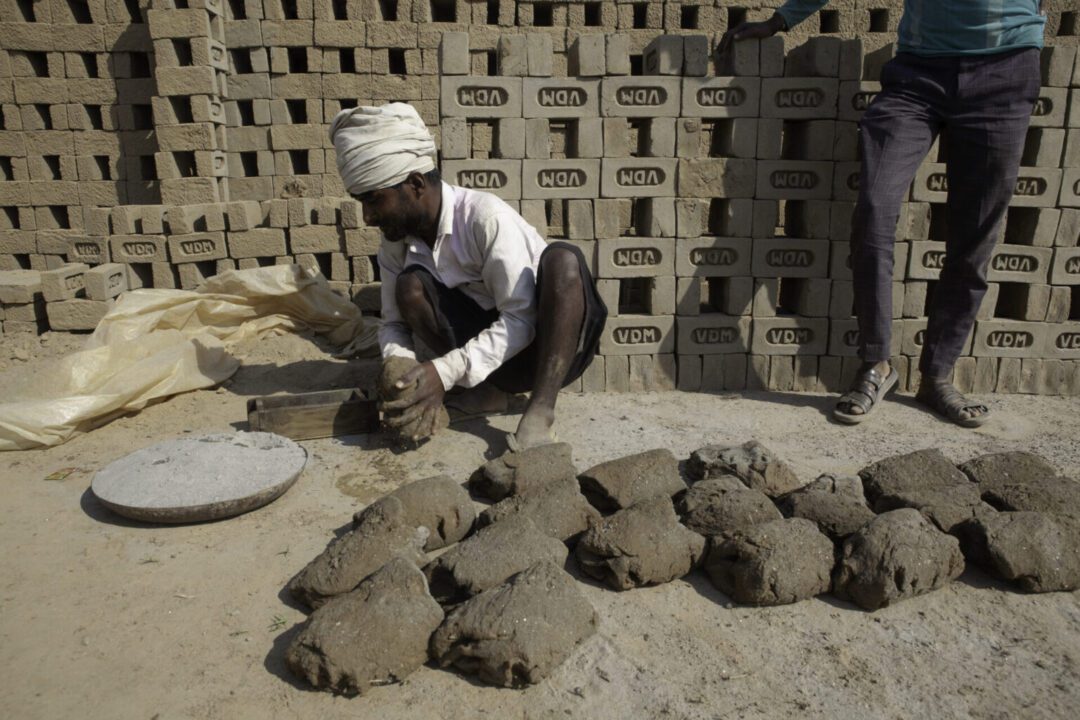Salata Institute researchers, supported by a Mittal Institute grant, argue that heat protections can’t end at the worksite: Many low-wage workers across the Global South return to homes that stay dangerously hot overnight

A man makes bricks in Uttar Pradesh, India. (photo: David Trilling)
Protecting workers from hazardous heat must not stop when they leave the job, argues a new analysis published on November 4 in the BMJ. Many low-wage workers – especially in India and across the Global South – face extreme heat on the job and then return home to sweltering rooms that don’t cool overnight. Workplace regulations are improving in some places, but they still miss large groups like informal and gig workers who often lack basic protections and can’t afford cooling, better housing, or lost wages from heat-related slowdowns.
The authors, led by Salata Institute postdoctoral research fellow Robert Meade, show that workplaces are already dangerously hot. Re-analyzing summer conditions at 19 South Indian worksites, they found that most temperatures exceeded safe limits, even for light or moderate tasks. In practical terms, that means workers must slow down or stop to avoid heat-related illnesses, with direct hits to their pay. Proposed fixes – more rest breaks, water stations, cooled break areas, or shifting hours – are important but tough to enforce, and they often clash with community routines and workers’ need to earn a full day’s income.
Re-analyzing summer conditions at 19 South Indian worksites, they found that most temperatures exceeded safe limits, even for light or moderate tasks.
Home is not a refuge, moreover. Many workers live in informal settlements built with heat-trapping materials and poor ventilation. Meade and colleagues also reanalyzed hourly temperatures at 51 low-income homes in New Delhi: Indoor temperatures often stayed high – or climbed – through the night, with some homes reaching 48°C (118.4°F). Tracking conditions from midsummer through the monsoon, they find that as humidity rises, the heat index (the “feels-like” temperature that combines heat and humidity) stays at dangerous levels day and night for over four months, and that the indoor heat index can exceed outdoor readings by up to 10°C (18°F). This constant exposure, and its negative effects on sleep and hydration, can harm the heart, raise the risk of injuries and kidney problems, and leave people less able to work the next day.
The paper’s main takeaway is that real adaptation must cool both worksites and homes.
Heat action plans should include targeted steps for outdoor and informal workers and for people in low-income housing, not just broad public warnings. Near-term, low-cost ideas like cool roofs and better ventilation can shave indoor temperatures by a couple of degrees, and newer reflective coatings may do more. However, in the longer-term, rapidly growing cities need climate-resilient housing built into national programs so new homes don’t bake their residents. The authors also point to community-led projects – like street-vendor shade grants, home “skylight” vents, parametric heat insurance, and trials of cool-roof coatings – as a smart way to test what actually protects health, income, and dignity.
In short: Safer jobs are essential, but without cooler homes, millions will still have nowhere to cool off.
Original article reproduced with permission from The Salata Institute for Climate and Sustainability at Harvard University
This and related work were seeded by an inaugural cluster grant from the Salata Institute, and supported by grants from the Mittal Institute, the Minderoo Foundation and more recently, Wellcome.
☆ The views represented herein are those of the interview subjects and do not necessarily reflect the views of the Mittal Institute, its staff, or its steering committee.
